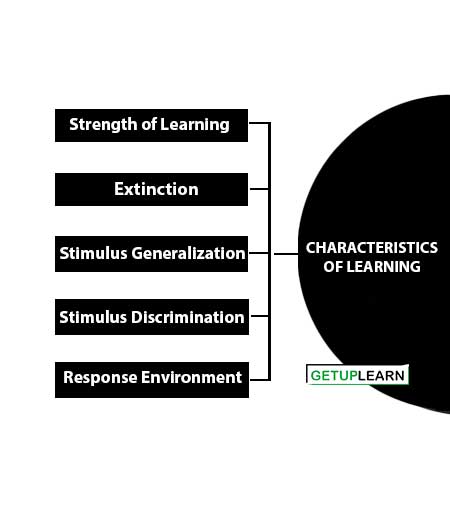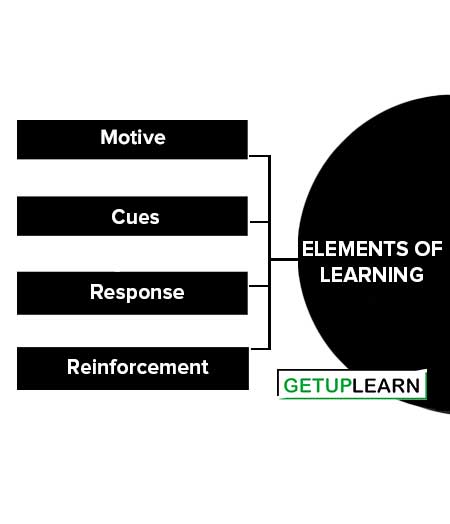Table of Contents
What is Learning?
Learning is a continuous process. It occurs all the time. Learning is a relative change in behavior that occurs as a result of experience.
We can say that changes in behavior indicate that learning has taken place and that learning is a change in behavior. Learning may be defined as a relatively permanent change in behavior as a result of prior experiences.
Definition of Learning
These are the two simple definitions of learning by authors:
Learning is a relatively permanent change in behaviour that occurs as a result of prior experience.” It can be said that change in behaviour indicates that learning has taken place and that learning is a change in behaviour.
E.R. Hilgard
Learning has taken place if an individual behaves reacts; respond as a result of experience in a manner different from the way he formerly behaved.
W. McGehee
Characteristics of Learning
These are the some of important characteristics of learning discussed below:
- Strength of Learning
- Extinction
- Stimulus Generalization
- Stimulus Discrimination
- Response Environment

Strength of Learning
What is required to bring about a strong and long-lasting learned response? Advertisements of most brands hammer into the customer the benefits and qualities of their respective brands so that the customer does not forget them. The strength of learning is heavily influenced by four factors: importance, reinforcement, repetition, and imagery.
- Importance refers to the value that the consumer places on the information to be learned.
- Reinforcement is anything, which increases the likelihood that a given response will be repeated in the future.
- Repetition increases the strength and speed of learning. Very simply, the more times we are exposed to information, or practice a certain kind of behavior, the more likely we are to learn it.
- Imagery refers to the images created by words. These words may either be a brand name or a corporate name.
Extinction
Marketers basically want consumers to learn and remember positive features, feelings, and behaviors associated with their brands. However, extinction or forgetting as it is more commonly termed occurs when the reinforcement for the learned response is withdrawn.
For instance, if the advertisements for a particular brand are withdrawn for a considerable period of time, both from the print and the electronic media, the probability of the brand being forgotten by the consumers is very high.
Stimulus Generalization
Stimulus generalization, often referred to as the rub-off effect occurs when a response to one stimulus is elicited by a similar but distinct stimulus.
Thus, a consumer who has learned over repeated use that surf detergent is effective and washes the best will assume that their Surf Excel will also be very effective. Thus, the consumer has engaged in stimulus generalization.
Stimulus Discrimination
Stimulus discrimination refers to the process of learning to respond differently to somewhat similar stimuli.
Response Environment
It appears that consumers generally learn more information than they are able to retrieve. That is, we frequently have relevant information stored in memory that we cannot access when desired.
One factor that influences our ability to retrieve stored information is the strength of original learning. The stronger the original learning the more likely relevant information will be retrieved when required.
Elements of Learning
Consumers learn in several ways. Primarily, there are four elements of learning:

Motive
Motives arouse individuals, thereby increasing their readiness to respond. This arousal function is essential since it activates the energy needed to engage in learning activity. In addition, any success at achieving the motivating goal, or avoiding some unpleasant situation, tends to reduce arousal.
Because this is reinforcing, such activity will have a greater tendency to occur again in similar situations. Thus, marketers strive to have their brand or its name available when relevant consumer motives are aroused because it is expected that consumers will learn a connection between the product and the motive.
Cues
A cue may be viewed as a weak stimulus not strong enough to arouse Consumers, but capable of providing direction to motivated activity. That is, it influences the manner in which consumers respond to a motive. The shopping environment is packed with cues, such as promotions and product colors, which consumers can use to choose between various response options in a learning situation.
For example, when we are hungry we are guided by certain cues, such as restaurant signs and the aroma of food cooking because we have learned that these stimuli are associated with food preparation and consumption.
Response
A response may be viewed as a mental or physical activity the consumer makes in reaction to a stimulus situation. Responses appropriate to a particular situation are learned over time through experience in facing that situation.
The occurrence of a response is not always observable. Therefore, it must again be emphasized that our inability to observe responses does not necessarily mean that learning is not taking place.
Reinforcement
The most widely acceptable view of reinforcement is anything that follows a response and increases the tendency for the response to reoccur in a similar situation. Because reinforced behavior tends to be repeated. Consumers can learn to develop successful means of responding to their needs of changing conditions.
Theories of Learning
When we act, we learn. Learning induces changes in our behavior arising from experience. Most human behavior is learned, although much learning is incidental. Learning theorists believe that learning is produced through the interplay of drives (motives), stimuli, cues, responses, and reinforcement.
Two popular approaches to learning are classical conditioning and operant conditioning. Learning theory teaches marketers that they can build demand for a product by associating it with strong drives, using motivating cues, and providing positive reinforcement.
A new company can enter the market by appealing to the same drives that competitors use and by providing similar cues because buyers are more likely to transfer loyalty to similar brands (generalization); or the company might design its brand to appeal to the different set of drives and offer strong cue inducements to switch (discrimination).

Classical Conditioning
Classical Conditioning is a type of conditioning in which an individual responds to some stimulus that would not ordinarily produce such a response. Classical conditioning has some important implications for understanding human behavior.
Since higher-order conditioning for learning by human beings is important, its implication must be recognized. Another implication of higher-order conditioning is that reinforcement can be acquired. A conditioned stimulus becomes reinforcing under higher-order conditioning.
Classical conditioning is passive. Something happens and we react in a specific way. It is voluntary rather than reflexive. For example, employees choose to arrive at work on time, ask their boss for help with problems, or “good off” when no one is watching. The learning of those behaviors is better understood by looking at operant conditioning.
Operant Conditioning
Operant Conditioning is a type of conditioning in which desired voluntary behavior leads to a reward or prevents a punishment. People learn to behave to get something they want or to avoid something they don’t want. Operant behavior means voluntary or learned behavior in contrast to reflexive or unlearned behavior.
The tendency to repeat such behavior is influenced by the reinforcement or lack of reinforcement brought about by the consequences of the behavior. Reinforcement, therefore, strengthens behavior and increases the likelihood that it will be repeated.
Cognitive Learning
Instead of viewing learning as the development of connections between stimuli and responses, cognitive theorists stress the importance of perception, problem-solving, and insight. This viewpoint contends that much learning occurs not as a result of trial and error or practice but through discovering meaningful patterns which enable us to solve problems.
Cognitive learning involves learning ideas, concepts, attitudes, and facts that contribute to our ability to reason, solve problems and learn relationships without direct experience or reinforcement. Cognitive learning can range from very simple information acquisition to complex, creative problem-solving.
Various types of cognitive learning could be:
Iconic Rote Learning
It involves learning the association between two or more concepts in the absence of conditioning.
Vicarious Learning
It is another important way in which consumer learning takes place. It is not necessary for consumers to directly experience a reward to learn. Instead, the consumer can observe the behavior of others and adjust that of his accordingly. Likewise, he may also use imagery to anticipate the outcome of various courses of action.
Reasoning
It represents the most complex form of cognitive learning. In reasoning, individuals engage in creative thinking to restructure and recombine existing information as well as new information to form new associations and concepts.
People can learn through observation and direct experience. Much of what we have learned comes from watching models-presents, teachers, peers, motion picture and television performers, bosses, and so forth. Social learning theory is an extension of operant conditioning is.
It assumes that behavior is a function of consequences it also acknowledges the existence of observational learning and the importance of perception in learning. Four processes to determine the influence that a model will have on an individual are:
- Attention Processes
- Retention Processes
- Motor Reproduction Processes
- Reinforcement Processes
Attention Processes
People learn from a model only when they recognize and pay attention to its critical features. We tend to be most influenced by models that are attractive, repeatedly available, important to us, or similar to us in our estimation.
Retention Processes
A model’s influence will depend on how well the individual remembers the model’s action after the model is no longer readily available.
Motor Reproduction Processes
After a person has seen a new behavior by observing the model, the watching must be converted into doing. This process then demonstrates that the individual can perform the modeled activities.
Reinforcement Processes
Individuals will be motivated to exhibit the modeled behavior if positive incentives or rewards are provided. Behaviors that are positively reinforced will be given more attention, learned better, and performed more often.
FAQs Section
What is the meaning of learning?
Learning is a relatively permanent change in behavior that occurs as a result of prior experience.” It can be said that a change in behavior indicates that learning has taken place and that learning is a change in behavior.
What is the simple definition of learning?
Learning has taken place if an individual behaves reacts; or responds as a result of an experience in a manner different from the way he formerly behaved.
What are the characteristics of learning?
Strength of Learning, Extinction, Stimulus Generalization, Stimulus Discrimination, and Response Environment are the characteristics of learning.
What are the elements of learning?
The four main elements of learning are Motive, Cues, Response, and Reinforcement.
